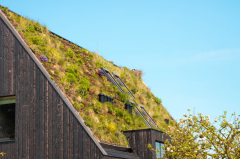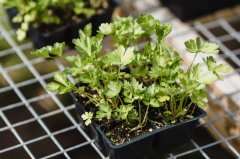Explore how sponge cities, rain gardens and depaving help manage rainwater and restore nature to our increasingly urban spaces.
Many years ago, Joni Mitchell sang about developers paving paradise and putting up a parking lot. Today, it is becoming increasingly common to see paved or concreted surfaces returned to nature, and this is not just as a concession to the hippy generation.
In built-up areas, impermeable hard surfaces have become ubiquitous. There was a logic behind this. Cities and towns were once unsanitary places with an excess of mud and filth, and after sewers came into use, the goal for managing excess water was to simply dispose of it. This arrangement worked relatively well until fairly recently. Now climate change is raising ocean temperatures, causing the air above to hold more moisture, which results in storms over land that are increasingly frequent and more intense. Surface water from flash flooding is liable to temporarily accumulate faster than it can drain away. The traditional drainage model is no longer working.
Current urban water design is shifting away from hard engineering towards permeability, with elements such as bioswales, rain gardens and green roofs increasingly commonplace as means for rainwater to percolate, reducing stormwater volumes. This fulfils a number of functions, the most important of which is to ameliorate the severity of floods. Groundwater depletion is a global issue, and allowing rainwater to infiltrate can recharge aquifers. Pollutants such as chemicals and oils that would otherwise be released into the environment are often absorbed by bacteria and fungi in the soil or filtering medium.
A “green and blue” nature- and water-focused urban infrastructure model is often referred to as the sponge city, and extends to parks, lakes, wetlands, woodlands and large peri-urban tree plantings such as the Orbital Forest around Tirana, the capital of Albania.
The origin of sponge cities
Kongjian Yu founded an innovative Chinese landscape architecture company called Turenscape in 1998. In the 1990s, he had studied overseas and, after returning later in the decade, he was disappointed to see the country embracing the Western concreteoriented paradigm when it came to infrastructure. Yu’s early speciality was to reclaim disused industrial sites and return them to nature.
He coined the term “sponge cities” in a 2003 publication and continued working out of the limelight for a decade until 2013, when President Xi Jinping adopted Yu’s model, launching China’s Sponge Cities Program. During 2015 and 2016, 30 pilot sponge cities were selected for projects. Today, Turenscape is behind more than 1000 sponge city initiatives in over 250 Chinese cities, plus others in France, Indonesia, Russia, Singapore, Thailand and the US.
China’s ambitious 2030 target is for 80 per cent of urban built-up areas to have sponge city adaptations, and for them to recycle at least 70 per cent of rainwater. Meanwhile, sponge city features were, perhaps unfairly, criticised because in 2023 they were no match for the severe weather. Beijing experienced its heaviest rain in at least 140 years, and flooding was widespread.
Innovative water design
One focal point for Turenscape’s activities has been China’s southern island of Hainan. With a monsoon climate, it can experience severe storms and flooding. The city of Sanya has converted a former landfill site adjoining a river into a mangrove park featuring a gentle slope with terraces and bioswales that cause water in the landscape to be slowed down and absorbed. It also features interlocking fingers of land and water channels.
Another Turenscape project is Benjakitti Forest Park in Bangkok, a city that has its own flood challenges. Similar to Sanya, this involves some constructed wetlands on a former industrial site. It features four lakes containing numerous grasstopped mound islands created using concrete that was recycled from the redevelopment. These mounds filter and clean water and also provide habitat for wildlife. Public access is via raised walkways.
Rotterdam in the Netherlands is redesigning a square with part-time water-retention ponds. Watersquare Benthemplein contains three stepped, sunken basins that double up as water storage areas in the wetter months. Two basins allow the water to seep into the groundwater, while a third, an overflow that only receives water after prolonged rain, releases its stormwater into the sewers.
In addition to other water-collecting features, Los Angeles County is pioneering large basins called “spreading grounds”, located in areas that are gravelly, rocky or sandy, allowing water to percolate. Currently 27 in number, they are bordered by embankments and can be several hectares in size or larger. The Tujunga Spreading Grounds in the suburb of Sun Valley occupy a vast area of 0.6 square kilometres.
Depaving
Depave is the name of a hands-on grassroots group that began in 2008 in Portland, Oregon, a US city with a reputation for being ultra-progressive. Its mission is, with the blessing of the owners, to replace hard surface areas such as unused edges of car parks with gardens. It has positioned itself as an anti-racist environmental justice organisation, engaging with the issue of urban heat islands that are worse in poorer neighbourhoods with a higher African-American population. One important element is a commitment by locals to manage and maintain the sites into the future.
The group has depaved more than 33,000 square metres, which results in 24.5 million gallons of water being diverted from storm drains every year. The scale of what such a community-based endeavour can achieve may seem insignificant in proportion to the scale of the challenge. Yet its most powerful effects may be in shifting attitudes, encouraging replication, and even leveraging action at a city-wide local government level.
Today, Depave is in touch with a network of similar groups, including Green Venture in Hamilton, Ontario, Canada, which operates along very similar lines. These ideas are receiving support from some local governments, such as the Belgian city of Leuven, which is focusing its depaving activities in the suburban district of Spaanse Kroon. The municipal authorities operate a small truck called a “tile taxi” that collects pavers and cobbles for free so that they can be reused elsewhere.
In Australia, Thami Croeser and his colleagues at RMIT Centre for Urban Research have looked into broad-scale depaving of Melbourne’s parking spaces, creating miniature gardens in their place. In a 2022 study, they simulated a number of scenarios, which included replacing up to half of the City of Melbourne’s 23,000 open-air parking spaces, yielding an addition





